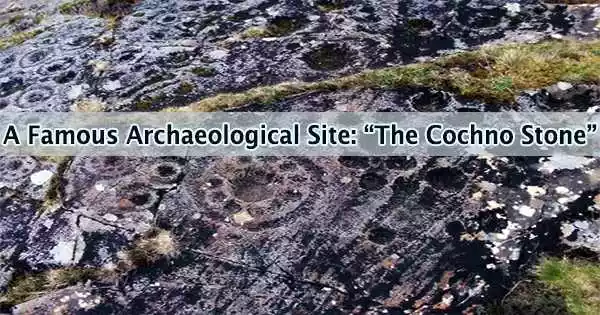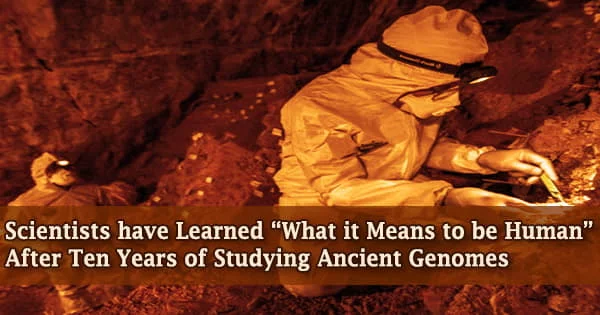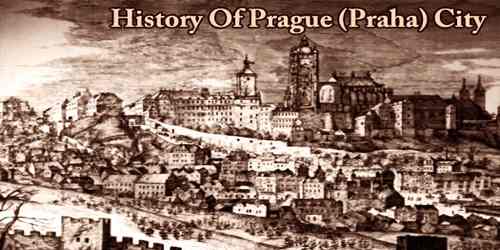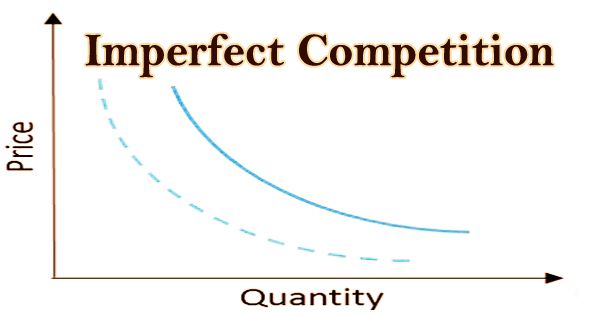Countless mysterious stones throughout the world contain the knowledge of our distant history. The Cochno Stone is a large cup and ring marked rock at Auchnacraig, Faifley, West Dunbartonshire, Scotland, next to the Cochno farm. It is renowned for its expansive and elaborate rock art, which includes multiple cup and ring marks along with other carvings. It is renowned for its expansive and elaborate rock art, which includes multiple cup and ring marks along with other carvings.
The stone is estimated to date back to the Neolithic or Bronze Age, making it thousands of years old. Impressively spanning a vast expanse measuring 43 feet by 26 feet (13 by 8 meters), the Cochno Stone bears witness to the creative expressions of our prehistoric ancestors. It features around 90 carved indentations, considered to be one of the finest sets of petroglyphs in Scotland.
The Cochno Stone is one of the most extensive Neolithic rock-art sites in Britain, a domed gritstone outcrop with over 100 cupmarks and cup-and-rings marks spread across an area almost 100 square metres. The stone is a massive, flat slab measuring approximately 42 feet (13 meters) by 26 feet (8 meters). Its size and the complexity of its carvings make it one of the most significant rock art panels in Europe.
The stone was reburied in 1965 to protect it against vandalism. In 2015 it was partially re-exposed for investigation during a 3-day dig by a team involving archaeologists from the University of Glasgow, with a more complete re-exposure following a year later.
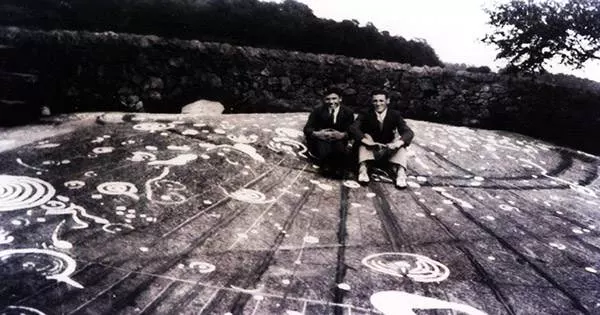
Two young men sitting on the Cochno Stone before its burial in 1965. Ludovic Mann’s paintjob is very clear.
Adorned with intricate swirling patterns referred to as “cup and ring marks,” this mesmerizing slab mirrors similar motifs found at archaeological sites across the globe. The Cochno Stone was first identified and recorded in the latter years of the 19th century by James Harvey, John Bruce and William Donnelly. Kenny Brophy, an esteemed archaeologist and senior lecturer at the University of Glasgow, suggests that this magnificent stone slab may serve as an exemplar of ancient artistic expression.
The site became something of a tourist attraction after Ludovic McLellan Mann painted the surface of the stone with oil paints in 1937. The prehistoric symbols (and natural marks) were painted white and green, and Mann covered the stone with an elaborate yellow, blue and red grid based on megalithic measurements and cosmological tales of his own devising. This led to the site being scheduled given legal protection immediately.
The contemporary archaeology and value of the Cochno Stone is as important to the community as the ancient past; as archaeologists our focus therefore needs to be on all aspects of site biographies, at Cochno and other carved stones.
Kenny Brophy
In 2016, after being buried for over 50 years, the Cochno Stone was unearthed and briefly exposed for research purposes. This was part of a project to document and study the carvings using modern archaeological techniques, including 3D laser scanning. However, as more and more visitors came to the site, and urbanisation brought big populations to the area, so the Cochno Stone became an increasing focus for new markings graffiti with names, initials and dates scraped onto the surface of the stone.
Decades ago, in the 1930s, researchers who studied the Cochno Stone speculated that the inscriptions adorning its surface may have been imbued with astronomical significance, aligning with celestial phenomena such as eclipses. However, Brophy and his team of dedicated researchers now offer an alternative perspective, challenging the previous notions surrounding the stone’s purpose. Driven by curiosity and a thirst for knowledge, they diligently explore the intricacies of the Cochno Stone, meticulously examining its features, and endeavoring to unravel the mysteries concealed within its ancient engravings.
The Cochno Stone is a Scheduled Ancient Monument, which means it is legally protected as an important archaeological site. Access to the stone is restricted to prevent damage. The ongoing study of the Cochno Stone serves as a fascinating exploration into the minds and lives of our prehistoric forebearers. Researchers delve into the cultural, social, and spiritual context of the era in which this monumental slab was created.
By investigating similar artifacts and analyzing parallel archaeological findings, they strive to uncover the significance and function of the Cochno Stone within the broader tapestry of human history. In 2016, Glasgow University, Factum Arte and the local community uncovered the Cochno Stone for ten days to allow the surface of the stone to be recorded by laser scanning and photogrammetry. This event was important because it opened up a dialogue with the local community, many of whom visited the excavations and shared their memories of playing on the Cochno Stone as children.

Cleaning the surface of the Cochno Stone during excavations in September 2016.
This remarkable stone slab not only reveals the remarkable artistic capabilities of our ancestors but also offers a portal into their belief systems and cultural practices. The Cochno Stone beckons us to reimagine the landscapes of the past, to envision the gatherings of prehistoric communities around this grand monument, and to contemplate the ceremonies, rituals, and traditions that may have unfolded in its presence.
The Cochno Stone continues to be of great interest to researchers and archaeologists due to its ancient carvings and the mysteries surrounding their purpose. While it may not be accessible to the general public in its uncovered state, its significance in understanding the prehistoric past of Scotland remains undeniable.
“The contemporary archaeology and value of the Cochno Stone is as important to the community as the ancient past; as archaeologists our focus therefore needs to be on all aspects of site biographies, at Cochno and other carved stones.” (Kenny Brophy, an esteemed archaeologist)
The Cochno Stone serves as a reminder that the pursuit of knowledge knows no bounds. It urges us to uncover the hidden narratives and cultural legacies that have shaped the trajectory of humanity. The mysterious stone continues to reveal its secrets in the capable hands of committed, enthusiastic scholars like Kenny Brophy and his team, enhancing our knowledge of the past and cultivating a deep appreciation for the resourcefulness of those who came before us.
